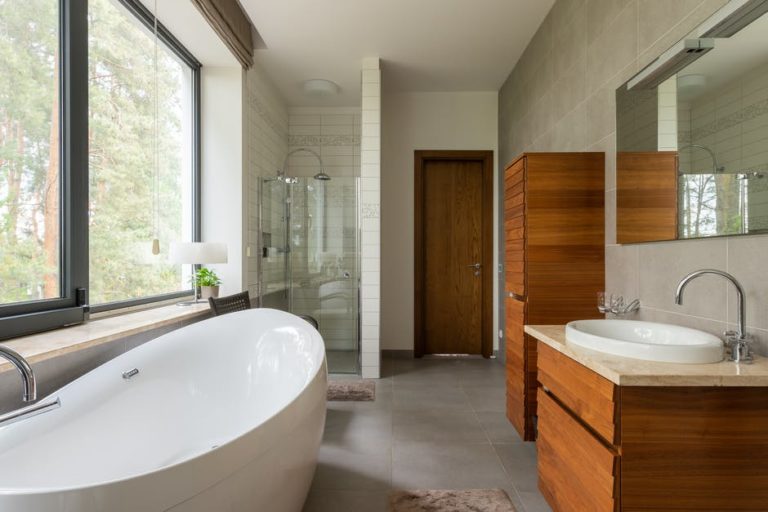
What is a Realistic Budget for a Bathroom Remodel?
Bathroom remodeling is one of the most common home improvement projects, and for good reason. An updated bathroom not only adds to your home’s functionality but also increases its value. However, how much should one expect to spend? Like any other home improvement project, the answer to this question largely depends on the size of the bathroom, the quality of materials, labor costs, and personal preferences. In this article, we’ll delve deep into understanding how to create a realistic budget for your bathroom remodel.
Setting the Groundwork: Understanding the Average Costs
On average, a bathroom remodel can range from $3,000 for minor cosmetic changes to $25,000 for a complete upscale transformation. According to data from Remodeling Magazine’s Cost vs. Value report:
- Midrange Bathroom Remodel: This includes updating an existing 5×7-foot bathroom with a new tub, toilet, solid-surface countertop, and ceramic tile. Average costs fall around $20,000.
- Upscale Bathroom Remodel: Encompassing expanding an existing 5×7-foot bathroom to 100 square feet, using top-notch materials like a freestanding soaker tub, stone countertops, and radiant heating. Costs can soar to $60,000 or more.
However, these are average figures, and costs can vary significantly based on your location and preferences.
Breaking Down the Costs
To understand the total cost, let’s break it down into some typical components:
- Labor: Generally constitutes about 40-60% of the budget. This includes plumbers, electricians, and other professionals.
- Fixtures: Items like sinks, tubs, and toilets can range from budget-friendly ($100 or less) to high-end ($1,000 or more).
- Cabinetry & Hardware: Depending on material and style, vanity prices can vary widely. Basic models may start at $200, while custom designs can run $2,000 or more.
- Countertops: Materials like granite or marble can drive the cost up significantly.
- Lighting & Ventilation: Budget at least $100 for basic fixtures and several hundred dollars if you’re opting for luxury or custom fixtures.
- Flooring: Prices can range from a few dollars per square foot for linoleum to $20 or more for ceramic or stone tile.
- Doors & Windows: A new window or glass shower door can be a significant but worthy expense.
- Walls & Ceilings: Painting is relatively inexpensive, but tile work can be pricey.
- Finishing Touches: Towel bars, shower curtains, mirrors, and other accessories can add another few hundred dollars.

Tips for Setting a Budget
- Evaluate Your Needs vs. Wants: A luxurious freestanding bathtub might be your dream, but if space doesn’t permit or it stretches your budget, consider more practical choices.
- Keep an Emergency Fund: It’s wise to set aside at least 10-20% of your budget for unforeseen costs. These might include hidden water damage, outdated electrical, or necessary structural repairs.
- DIY vs. Professional Labor: Decide which tasks you can handle and which ones require a professional. Doing some work yourself can save money but ensure the job is done right, especially for plumbing and electrical tasks.
- Shop Around: Get quotes from multiple contractors and compare costs for materials at different stores or online.
- Consider Long-Term ROI: Quality materials and craftsmanship may cost more initially but can offer a better return on investment in the long run.
Setting a realistic budget for a bathroom remodel involves a mix of research, realistic expectations, and a clear understanding of your vision for the space. While it’s tempting to opt for the cheapest options, remember that this is a space you’ll use daily. Quality matters. Remember, remodeling is not just about aesthetics. A functional, comfortable, and beautiful bathroom can significantly enhance your daily routine and boost your property’s value. So, plan carefully, allocate funds wisely, and soon you’ll have a bathroom that brings joy and relaxation.
What is Included in a Bathroom Remodel?
Bathroom renovations vary from straightforward fixture replacements to a complete overhaul. The extent of your remodel will be influenced by your aspirations, needs, and budget. Here’s a detailed breakdown of what can be covered in different bathroom updates.
Basic Bathroom Update
In these renovations, the focus is on:
- Refreshing fixtures such as taps, showerheads, and lights.
- Painting the walls and ceiling anew.
- Modernizing the vanity or mirror.
- Addressing tile issues by sealing or re-grouting.
Mid-Range Bathroom Remodel
A deeper dive into remodeling might involve:
- Introducing a new bathtub or making the switch from a tub to a walk-in shower.
- Upgrading the toilet to a modern, potentially water-saving variant.
- Revamping with new tiles on both floor and wall areas.
- Swapping out the vanity, sink, and countertop.
- Enhancing the lighting scenario with additions like sconces or overhead fixtures.
- Ventilation upgrades to safeguard against mold and guarantee improved air circulation.
- Refining the bathroom window or making necessary adjustments for improved airflow and illumination.

High-End Bathroom Overhaul
For those leaning towards luxury, the modifications might include:
- Incorporation of amenities like a whirlpool tub or a steam shower.
- Installation of comforts such as heated floors or warming towel racks.
- Introduction of double vanities or ornate vessel sinks.
- Adoption of premium materials, for instance, marble or natural stone for various surfaces.
- Integration of state-of-the-art tech elements like digital shower controls, intelligent mirrors, or in-built speaker systems.
- Carving out a distinct space for the toilet.
- Introducing architectural elements, maybe a skylight or recessed shelving.
Structural Changes and Additions
Occasionally, a bathroom renovation calls for more structural shifts:
- Complete alteration of the bathroom’s layout.
- Expansion strategies, either by annexing space from neighboring rooms or constructing a new addition.
- The addition or relocation of plumbing and electrical arrangements.
- Floor joist fortification to accommodate weightier fixtures or tubs.
- Enhancements or alterations to the bathroom’s ventilation mechanisms.
- Introduction or expansion of windows.
In your bathroom remodeling journey, commence by pinpointing your requirements, wishes, and financial limitations. This approach aids in zeroing in on the changes that will enrich your home and daily existence. Whether minor or major, the ultimate aim remains a harmonious blend of utility, comfort, and visual appeal in your bathroom space.
Popular Bathroom Remodeling Materials in 2023
In 2023, homeowners are seeking both durability and aesthetics in their bathroom remodeling projects. With a myriad of materials available in the market, choices are driven by budget, design preferences, and the overall desired ambiance. Here’s a look at the materials that have made it to the top of the list this year:
Porcelain and Ceramic Tiles
Cost: Porcelain and ceramic tiles typically range from $5 to $15 per square foot.
Why They’re Favorable: Both porcelain and ceramic tiles are revered for their durability and water-resistance. Porcelain, in particular, is denser and less porous than ceramic, making it an excellent choice for areas exposed to too much moisture. Their diverse design options and relatively affordable cost make them a go-to choice for both floor and wall applications.

Natural Stone (Marble, Granite, Slate)
Cost: Prices can vary widely, from $15 per square foot for some types of granite to $150 or more for high-end marble.
Why They’re Favorable: The luxury and timeless beauty that natural stone brings to a bathroom is unmatched. Each slab boasts unique veining and color variations. Marble exudes elegance, granite offers robust durability, and slate provides a rustic, textured finish. Though they require regular sealing to prevent staining and maintain their beauty, their upscale look justifies the effort.
Quartz and Engineered Stone
Cost: Generally, quartz countertops will set homeowners back between $50 to $150 per square foot.
Why They’re Favorable: Quartz has gained immense popularity due to its non-porous nature, which makes it resistant to staining and bacteria. Its consistency in pattern allows for seamless designs, and its durability rivals that of natural stone without the need for regular resealing.
Acrylic and Fiberglass for Showers and Tubs
Cost: Acrylic and fiberglass units can range from $200 for basic models to over $2,000 for premium designs.
Why They’re Favorable: These materials are lightweight, making them easier to install than some traditional materials. They offer a smooth, sleek appearance and are inherently resistant to mold and mildew. Their non-porous nature also means they’re less likely to stain, making cleaning and maintenance a breeze.
Glass for Shower Enclosures
Cost: Basic enclosures start around $700 but can exceed $3,000 for custom installations.
Why They’re Favorable: Glass enclosures give bathrooms an open, airy feel, and they visually enlarge the space. Whether frosted, clear, or patterned, glass can be tailored to fit various design preferences. It’s also easier to clean than shower curtains and adds a touch of modern sophistication.
Concrete
Cost: Bathroom concrete applications can cost anywhere from $65 to $135 per square foot.
Why They’re Favorable: Concrete’s adaptability means it can be molded into a variety of shapes and designs, making it suitable for countertops, sinks, and even bathtubs. It can be dyed, polished, and sealed to fit different aesthetics, from industrial to upscale. Its heat retention properties also make it a favored choice for those looking to add a touch of warmth.
In 2023, the emphasis is on materials that offer both functionality and design flexibility. While the initial cost of some materials may be high, their durability and timeless appeal often make them a worthwhile investment in the long run. When choosing materials, it’s crucial to consider not just the upfront cost but also the long-term maintenance needs and the value they add to the home.

Bathroom Remodeling Trends to Consider
As we navigate through 2023, bathrooms are increasingly viewed as personal sanctuaries, spaces where one can unwind and escape from daily stressors. This shift in perception has paved the way for several emerging design and functionality trends. If you’re planning a bathroom remodel, here are some of the hottest trends to consider incorporating into your design:
Spa-Inspired Designs
The lines between high-end spas and residential bathrooms continue to blur. Homeowners are seeking to recreate the serene ambiance of a spa in their own homes. This trend often manifests through the inclusion of deep-soaking tubs, rain showerheads, aromatherapy elements, and even integrated sound systems to play calming tunes.
Earthy Tones and Biophilic Design
Drawing inspiration from nature, bathrooms are being adorned in earthy tones such as deep greens, warm browns, and muted blues. These colors elicit a sense of calm and are often complemented by the use of natural materials like wood and stone. Biophilic design, which involves integrating elements of the natural environment into built spaces, is becoming increasingly prevalent. This could mean the incorporation of plants, the use of natural light, or the replication of natural shapes and forms in fixtures and fittings.
Smart Bathroom Technology
The bathroom hasn’t been left behind in the smart home revolution. Tech-driven additions are gaining traction, from mirrors with integrated displays and lighting to high-tech toilets with features like self-cleaning capabilities, heated seats, and even mood lighting. There’s also a rise in digitally controlled showers that allow users to set their preferred water temperature and flow intensity.
Floating Vanities
Floating vanities offer a clean, contemporary look. Aside from their aesthetic appeal, they also provide the illusion of more space, making them an excellent choice for smaller bathrooms. These vanities, often complemented with sleek hardware and under-vanity lighting, infuse a touch of luxury and modernity into the space.
Integrated Lighting
Lighting plays a pivotal role in setting the mood in a bathroom. Integrated lighting solutions, whether built into mirrors, vanities, or even tubs and showers, provide both functionality and design flair. LED strips, for instance, are becoming a popular choice for ambient lighting, adding both elegance and warmth to the space.
Textured Finishes
While smooth finishes have long dominated bathroom designs, there’s a growing inclination towards textured finishes, bringing depth and character to the room. Be it textured tiles, fixtures, or accessories, these finishes add a tactile dimension to the bathroom, creating a multi-sensory experience.
Statement Tubs
Freestanding tubs, especially those with unique shapes or finishes, are becoming the focal point in many modern bathrooms. They act as statement pieces, and when placed strategically, they can transform the bathroom’s overall aesthetic. Materials like stone, copper, or even tinted acrylic are making waves in tub designs.

Considering the evolving trends, it’s evident that today’s bathroom remodels are about more than just functionality. They aim to create a holistic experience, a space that resonates with the homeowner’s personality while offering a slice of daily luxury and relaxation. As always, while trends provide direction, the best choices will always be those that align with personal preferences and the specific constraints and opportunities presented by the space.
Hiring a Contractor for Bathroom Remodeling: Costs Explored
Bathroom remodels can range from simple upgrades to intricate overhauls, and the choice to hire a contractor often depends on the complexity of the project. If you’re considering this route, it’s essential to understand the associated costs.
Average Cost of Labor
The labor cost is typically the most significant expense in a bathroom renovation. As of 2023, the average labor cost for a bathroom contractor ranges between $40 to $100 per hour, depending on the region and the expertise of the contractor. Urban areas or regions with a higher cost of living generally have contractors charging on the higher end of this spectrum.
It’s also worth noting that specific tasks might have varying rates. For instance, a plumber or electrician might charge more per hour than a general laborer. Similarly, specialized tasks such as custom tile work or intricate installations can command higher hourly rates due to the expertise required.
Flat Fees vs. Hourly Rates
Many contractors offer a flat fee for the entirety of a bathroom remodel, especially for more comprehensive projects. This fee is an all-inclusive quote that encompasses labor, materials, and other associated costs. Offering a flat fee can be beneficial for homeowners as it provides a clear idea of the total cost upfront, ensuring there are no unexpected expenses.
For a mid-range bathroom remodel, the flat fee charged by contractors can range from $10,000 to $20,000. However, for high-end, luxury bathroom overhauls, this fee can easily exceed $30,000. It’s essential to clarify what the flat fee covers. For example, does it include premium finishes, permits, or any potential costs that might arise due to unforeseen challenges?
Factors Influencing Contractor Costs
Several factors can influence how much a contractor will charge:
- Project Complexity: A simple bathroom update will naturally cost less than a complete overhaul involving structural changes.
- Bathroom Size: Larger bathrooms will require more materials and labor.
- Materials Used: Premium materials can drive up the cost, both in terms of the materials themselves and the expertise required to install them.
- Permit Costs: Some remodels, especially those that involve significant changes to plumbing or electrical systems, might require permits, adding to the cost.
- Unexpected Repairs: Older homes, in particular, might have hidden issues that only become apparent once the remodel begins, like rotten subfloors or outdated wiring.

Tips for Hiring a Contractor
If you decide to hire a contractor for your bathroom remodel, here are a few tips to keep in mind:
- Gather Multiple Quotes: It’s always a good idea to get at least three estimates to gauge the average cost in your area and make an informed decision.
- Check References and Past Work: Always ask for and review references. If possible, visit some of the contractor’s completed projects.
- Understand the Contract: Ensure every detail, from the project timeline to the materials used, is outlined in the contract. This clarity will prevent any potential misunderstandings.
While hiring a contractor does involve additional costs, the expertise and peace of mind they bring to a bathroom remodeling project can be invaluable. By understanding the associated costs and diligently researching potential contractors, homeowners can ensure they get the best value for their investment.
Top Cost-Saving Tips for Your Bathroom Remodel
Embarking on a bathroom remodel is undoubtedly exciting, but it’s also an endeavor that can quickly become expensive. Whether you’re working with a tight budget or just looking to get the most bang for your buck, here are some cost-saving strategies to consider:
1. Plan Ahead
Perhaps the most crucial money-saving tip is to plan meticulously. This includes understanding the layout of your bathroom, the changes you’d like to make, and establishing a clear budget. A well-thought-out plan helps in avoiding costly mistakes and last-minute decisions that can inflate costs.
2. Retain the Original Layout
Moving plumbing fixtures can significantly increase the cost of your remodel. If possible, try to retain the original layout of your bathroom, especially the toilet, sink, and bathtub or shower. By doing so, you can save money on plumbing and construction expenses.
3. Refinish Instead of Replace
If your bathtub, sink, or tiles are in decent condition but just look outdated, consider refinishing them instead of replacing. Refinishing can give these fixtures a fresh, new look at a fraction of the cost of complete replacement.
4. Shop Sales and Discounts
Always be on the lookout for sales, discounts, or clearance sections in home improvement stores. You might find high-quality items at significantly reduced prices. Off-season sales or end-of-line products can offer especially good deals.
5. Opt for Alternatives
While we all might love the look of natural stone or high-end fixtures, they can be quite pricey. Fortunately, many alternative materials look almost as good but come at a lower price point. For instance, consider using laminate or quartz instead of granite or marble.

6. Repurpose and Upcycle
Before discarding any old furniture or fixtures, think about whether they can be repurposed for your new bathroom design. An old dresser, for example, can be transformed into a unique bathroom vanity.
7. Do Some Work Yourself
While certain tasks require professional expertise, there are aspects of a bathroom remodel that you can tackle yourself, such as painting or installing simple fixtures. Just ensure that you’re comfortable with the task and have the necessary tools and knowledge.
8. Limit Tile Usage
Tiles can be expensive, especially if you’re hiring someone to lay them. Consider limiting the amount of tile in your bathroom, perhaps by only tiling the floor and a section of the wall instead of the entire space.
9. Prioritize Investments
Determine which aspects of the bathroom are most important to you and invest in those. If a high-end faucet is what you desire, perhaps you can save on the vanity or lighting fixtures.
10. Avoid Last-Minute Changes
Once you’ve started the remodeling process, making changes can be both costly and time-consuming. Stick to the plan as much as possible, unless unforeseen issues arise.
11. Get Multiple Contractor Bids
If you’re hiring a contractor, don’t just settle for the first quote you receive. Collect multiple bids to understand the average cost and choose a contractor that offers the best balance of cost and quality.
12. Consider Long-Term Savings
Sometimes, spending a bit more upfront can result in long-term savings. For example, investing in water-saving fixtures or energy-efficient lighting might have a higher initial cost but will save on utility bills in the long run.
Remodeling your bathroom doesn’t have to break the bank. By being strategic, doing thorough research, and making informed decisions, you can achieve a beautiful result that aligns with your budget and vision.

Does Bathroom Remodeling Increase Your Home’s Value?
The short answer is yes, bathroom remodeling often leads to an increase in home value. Bathrooms, along with kitchens, typically offer the highest return on investment (ROI) when it comes to home improvement projects. Potential buyers often prioritize modern, functional, and aesthetically pleasing bathrooms when seeking a new home.
A well-executed bathroom remodel can provide an estimated ROI of 50% to 70%. However, it’s crucial to strike a balance. Overly personalized or extravagant remodels might not resonate with all potential buyers, potentially limiting your ROI. For the best returns, focus on modern, neutral, and universally appealing designs and improvements.
Setting Your Bathroom Remodeling Budget
When setting a budget for your bathroom remodel, it’s crucial to ensure that it aligns with your financial capacity, the scope of the project, and the potential ROI. Here’s a guideline on how to set and allocate your bathroom remodeling budget:
- Determine the Total Amount: Start by determining how much you’re willing to spend in total. This could be based on savings set aside for the remodel, home equity loans, or other financing methods. A common recommendation is to spend no more than 5-10% of your home’s value on a bathroom remodel, especially if you plan to sell within the next few years.
- Factor in Unexpected Costs: Always keep a buffer for unforeseen expenses, typically around 10-20% of your total budget. This can cover unexpected issues like plumbing problems, mold, or structural challenges that might arise during the remodel.
- Itemized Budgeting: Breaking down your budget into specific categories or projects will help ensure you don’t overspend in one area while neglecting another. Here’s a rough breakdown:
- Design and Planning (10%): This includes fees for architects, interior designers, or any pre-construction assessments.
- Installation and Labor (20%): This is the cost of hiring contractors or any labor fees associated with the remodel.
- Fixtures (15%): Allocate funds for fixtures like faucets, sinks, showers, and bathtubs.
- Cabinetry & Hardware (16%): This covers the cost of vanities, cabinets, and associated hardware like handles and knobs.
- Countertops (7%): Depending on the material chosen, this might fluctuate. Granite, for instance, would be pricier than laminate.
- Lighting & Ventilation (5%): Invest in good quality lighting fixtures and ensure proper ventilation.
- Flooring (9%): Depending on whether you choose tile, laminate, or another material, the costs can vary.
- Doors & Windows (4%): This includes any replacements or upgrades for doors and windows.
- Walls & Ceilings (5%): Allocation for painting, tiling, or any decorative elements.
- Plumbing (9%): This might be higher if there are significant plumbing changes or updates.
- Additional Features (5%): For any extras, such as unique lighting, advanced toilet systems, or special amenities like heated towel rails.
- Prioritize Investments: Once you’ve established these categories, decide which areas are non-negotiable and which you’re flexible on. For instance, if you’re committed to a high-end vanity, you might choose to save on lighting or fixtures.
- Get Quotes: Before finalizing your budget, obtain quotes for the major expenses. This will provide a clearer picture of the potential costs and allow you to make informed adjustments.
Bathroom remodeling can be a fruitful investment both for personal satisfaction and boosting home value. By setting a clear budget and being judicious in your spending, you can ensure your remodel achieves the desired outcome without straining your finances.


